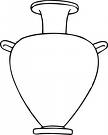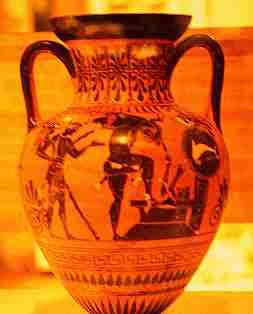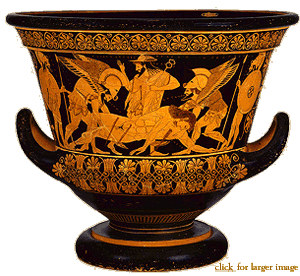Cards In This Set
| Front | Back |
|
The sun god
|
Apollo
|
|
A part man part goat represent animal instinct
other is a associated with females
|
Satyr and nypmh
|
 Basic shape of a vase all purpose decorative used to store things |
Amphora
|
 Used special celebrations variation of amphora |
Greek panathenaic vase
|
 Used as a water container widemouth very heavy used small cup to get h20 out"valute" |
Greek hydria vase
|
 Wine container wide mouth used as wine container |
Greek krater vase aka calyx
|
 Drinking cup used sometimes mix water and wine looks like a shallow bowl decoration was on inside |
Greek kylix
|
|
Called the lost cast waxing
|
Wax casting
|
|
During this period: Pottery ornamented with geometric decoration. People and animals are simplified.
a. Orientalizing (c. 700-600 B.C.)
b. Geometric (c. 1000-700 B.C.) c. Archaic (c. 600-480 B.C.) d.Early Classical/Severe (c. 480-450 B.C.) |
Geometric (c. 1000-700 B.C.)
|
|
During this period: Near Eastern influences on Greek pottery includes curvilinear decoration and greater emphasis on narrative.
a. Orientalizing (c. 700-600 B.C.)
b. Geometric (c. 1000-700 B.C.) c. Archaic (c. 600-480 B.C.) d.Early Classical/Severe (c. 480-450 B.C.) |
A. Orientalizing (c. 700-600 B.C.)
|
|
During this period: Sculptures include kouros and kore figures. Pottery includes black- and red-figured vase painting.
a. Orientalizing (c. 700-600 B.C.)
b. Geometric (c. 1000-700 B.C.) c. Archaic (c. 600-480 B.C.) d.Early Classical/Severe (c. 480-450 B.C.) |
C. Archaic (c. 600-480 B.C.)
|
|
Large, freestanding sculptures with figures shown in movement. Contrapposto (weight shift) shown for the first time.
a. Orientalizing (c. 700-600 B.C.)
b. Geometric (c. 1000-700 B.C.) c. Archaic (c. 600-480 B.C.) d.Early Classical/Severe (c. 480-450 B.C.) |
D.Early Classical/Severe (c. 480-450 B.C.)
|
|
"High point" of Greek art and architecture. Figures are idealized, with expressionless faces. Proportion and symmetry are emphasized.
a. Classical (c. 450-400 B.C.)
b. Geometric (c. 1000-700 B.C.)
c. Late Classical (4th century B.C.)
d.Hellenistic |
A. Classical (c. 450-400 B.C.)
|
|
Discovered by an Abaloni diver in Riacci Italy
Named individually
contracossta pose
detali muscle
more individualized
a. riacce warriors
b.mausoleum at Hallicarnassos
b.statues on Quadriga
|
A. riacce warriors
|
|
-on coast of asia minor
a large tomb
first bldg mamed after a person
used to be one 7 wonders of the world
3 tiered look like a ziggurat
a. riacce warriors
b.mausoleum at Hallicarnassos
b.statues on Quadriga
|
B.mausoleum at Hallicarnassos
|



